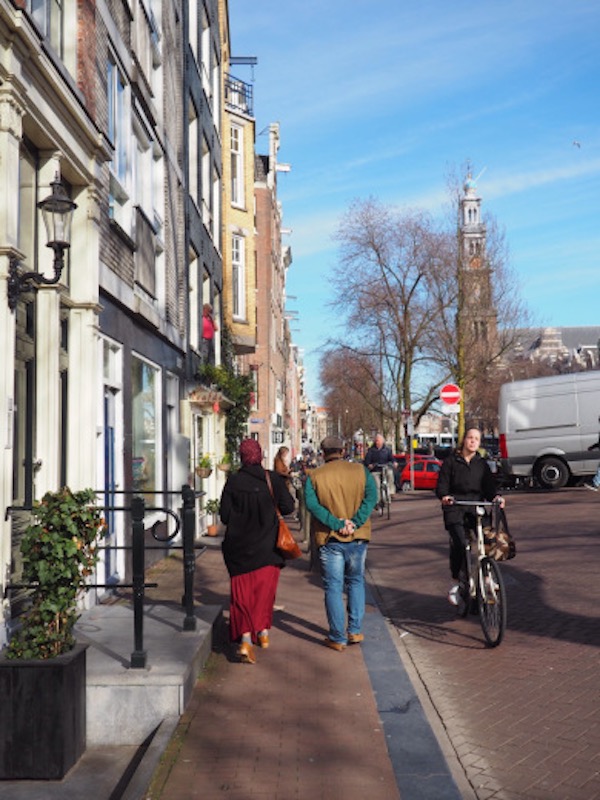
Amsterdam is a city where 48% of all trips made in the city centre are made by bicycle. A total of 78% of trips in the region are made by walking, cycling and transit. Only 22% of trips are made by cars. This is most impressive when you notice who is cycling, as you will see people of all ages, and significantly more women cycling. People are dressed in everyday clothes and carry out typical everyday tasks.
With the resurgence of cycling around the world, Amsterdam in often the subject of case studies. People often assume that the Dutch culture operate in a elevated understanding of all things cycling. However there have been very surprising discoveries while exploring this city. Many of these observations reveal that the Dutch are not a divine cycling culture, and pleasantly highlight that there are basic steps other cities can take to move towards a safer and inviting cycling and walking environment.
1. There is still a place for cars.

Despite the high rate of people cycling, cars were still seen parked in every nook and cranny of the city. Supporting cycling does not mean that you banish the vehicle outright, you permit access for cars but tolerate them at slower speeds. This demonstrates other cities can achieve a high cycling rates while still accommodating the automobile.
From our partners:
2. When you don’t want cars, use barriers to keep them out.

The Dutch do not operate from an elevated state of mind. When the Dutch want to keep traffic out, they put up barriers. When they want traffic to slow down, they build the road to feel unsafe at unsafe speeds. The Dutch do not plan on good faith from people driving and anticipate that vehicles will take advantage of a situation. Consequently the Dutch physically build the roadway to get the result they want, which is to slow down traffic to protect people walking, cycling and using transit and create a pleasant place to live, work and play. When you narrow the street, use chicanes to make travelling in a straight line impossible, and make streets incredibly pleasant places to walk, bike and stay, these all make people driving think twice about their speed.
3. Not all cycling routes are separated from vehicle traffic.

In North America there is currently a fixation on adding separated cycling lanes in every city. While it is great to finally see movement to provide safe, convenient access for cycling. However we must not assume a one size solution fits all, that is what got us where we are in the first place with an auto-oriented priority. We must not lose sight that there are other tools to achieve the same results. Only 50% of the cycling routes in the Netherlands are separated from vehicular traffic. According to the C.R.O.W. Manual the Dutch only use separated or protected cycling lanes when the traffic volumes and speeds are sufficient high enough to pose a threat to lives of people cycling. Alternatively the Dutch use painted bike lanes, shared streets and woonerfs (a residential version of the shared street. In all cases the Dutch ensure that the physical design of the street only tolerates a safe vehicle speed, they do not rely on suggestive tools such as posted speed limits.
4. Retail streets still survive and in fact thrive.
Most businesses in North America oppose adding bike lanes in front of their businesses for the fear of losing driving customers and running out of business. Businesses often over estimate how many of their customers drive. The businesses in Amsterdam not only survive with a bike lane in front of their business, but they thrive as inviting, interesting places to shop, live and play. It is important to point out that one concern of businesses may have some teeth to it, parking must be maintained as explained by the next point.
5. Parking and vehicular access is provided on almost all retail streets.

With the provision of on-street parking on almost all retail streets in Amsterdam, it is clear that providing access for vehicles is still important. Parking is also critical for providing access for deliveries of supplies. This way all modes of transportation can access the businesses safely and comfortably, maximizing the potential patrons for businesses.
6. Bike lanes do not prevent crucial business deliveries.

As mentioned above, by maintaining on-street parking on retail streets, access for loading and unloading is still provided for delivery trucks without having them block traffic by double parking in the travel lane. In addition to this large vehicles can be found in most places in Amsterdam.
7. Street widths in Amsterdam are comparable to North America.

The excuse often in North America is that there is no room on the streets for bike lanes. The streets in Amsterdam have comparable widths but can still accommodate a complete street including wide sidewalks, patios, two cycling lanes, two parking lanes and two lanes of traffic. Even larger streets also accommodate at least two lanes of transit and transit stops.
8. Transit stops and bike lanes can mix.

We need to stop reinventing the wheel! Often in North America bikes and buses will share a curb side lane creating a dangerous situation. People cycling are forced to overtake the bus at transit stops, which inevitably results in a bus, cycling chicken game with each constantly overtaking the other. The Dutch have already figured out how to make cycling and transit coexist, using floating transit stops and generous sidewalks it works. People cycling can go around the transit stop maintaining their dedicated right of way, while transit patrons can still board and disembark the vehicle safely and efficiently.
This feature is written by Darren Proulx and originally appeared in Urban Reality.



















